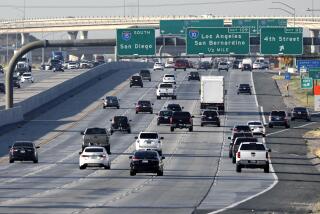Experts Cite Immaturity, Inexperience in Teen Fatalities
- Share via
The crash scene in Santa Clarita and the stories of young lives lost were all too familiar, researchers and traffic safety experts said Friday, noting that teenagers are involved in more accidents resulting in death and serious injury than any other age group.
Although teenagers generally drive less than older people, they are involved in a disproportionately larger number of crashes and related deaths and comprise the age group most at risk of being in an accident, experts said.
“Not much has changed through the years,” said Lou Aviles, a California Highway Patrol officer who has worked at the scene of several teen fatalities. “It’s always been a problem.”
Statewide, 1,019 18-year-olds died in traffic-related deaths in 1998, ranking first among all age groups in traffic fatalities, according to the CHP. Nationally, more teenagers died in traffic accidents in 1998 than any other age group with 5,606 fatalities, according to the Insurance Institute for Highway Safety in Arlington, Va.
Despite years of prevention efforts, including public service announcements on traffic safety, experts said teenagers still are more likely to speed, drive without wearing seat belts, become distracted while driving, pile five or more passengers into a single vehicle and disobey traffic laws.
In the Santa Clarita crash Thursday night, the driver of the white Acura Integra carrying five teenagers allegedly was speeding about 100 mph down a bicycle lane on Soledad Canyon Road, rap music blaring, when the car hurtled through the center divider and ran head-on into a blue Mustang, police said.
The driver of the Mustang and three seniors at Canyon High School were killed. The other two teenagers were treated at a local hospital and released.
“Inexperience and immaturity make for a lethal combination,” said Julie Rochman, a spokeswoman with the highway safety institute. “Teenage drivers are more willing to take risks. They think they’re invincible.”
Rochman said erratic driving among teenagers cuts through ethnic and socioeconomic backgrounds.
To minimize the number of motor vehicle fatalities and injuries among young people, California legislators passed the Teen Driver Safety Act, which took effect in July 1998.
The law phases in driving privileges by extending the learner’s permit time from 30 days to six months and assigning teenagers provisional licenses, which they receive after passing a driving test and keep until they turn 18.
During the first six months of the provisional license, teenagers may drive on their own but may not transport passengers under age 20 without someone 25 or older in the car. The law also forbids teenagers from driving between midnight and 5 a.m. unless accompanied by a driver who is 25 or older.
Early data suggests the law has been effective. For the first three months of 1999, fatal and injury accidents caused by 16- and 17-year-old drivers dropped 5%, compared with early 1998, when the law was not in effect.
“It’s a little early to draw a strong conclusion,” said Arline Dillman, manager of traffic safety for the Automobile Club of Southern California, which supported the law. “But [the data] certainly suggest it’s helping. In the long run, it has to help.”
More to Read
Sign up for Essential California
The most important California stories and recommendations in your inbox every morning.
You may occasionally receive promotional content from the Los Angeles Times.










